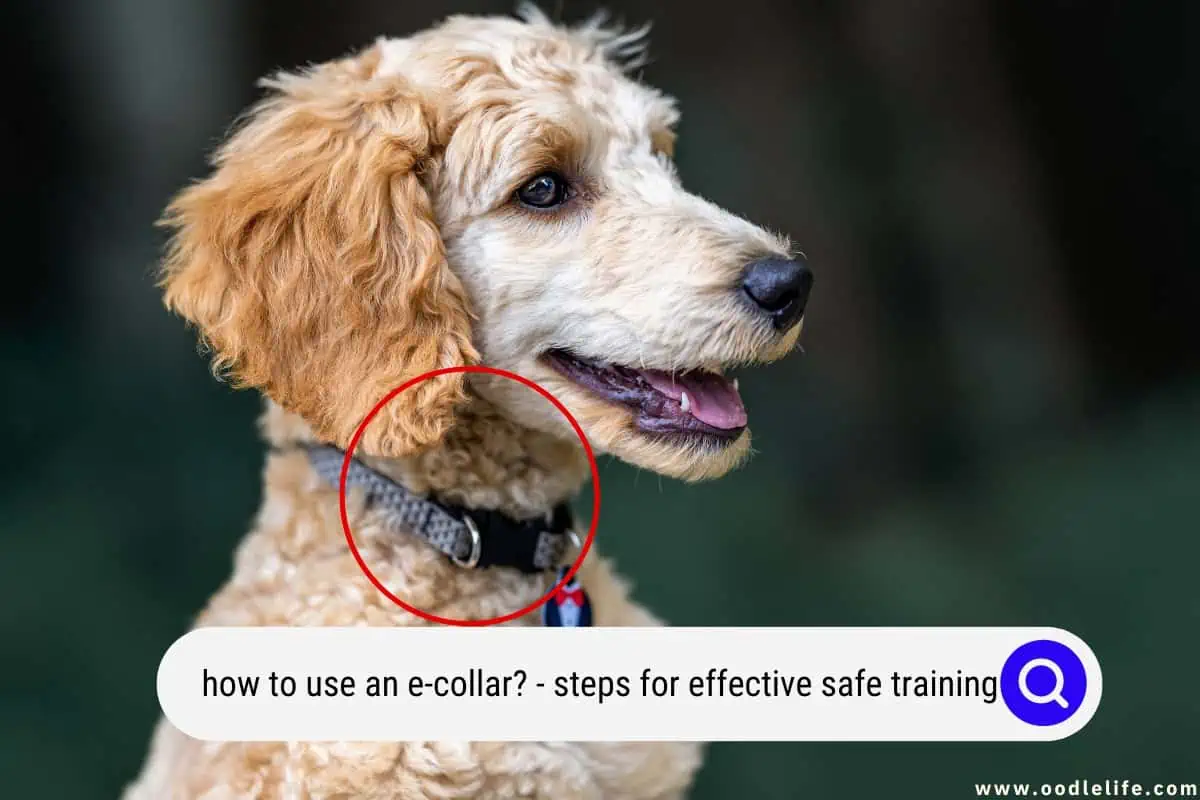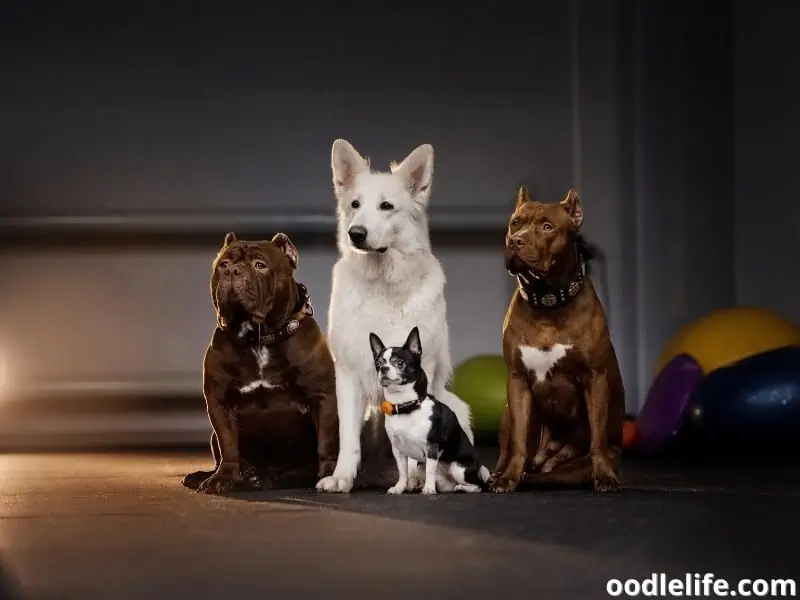How To Use an E-Collar? (Steps for Effective Safe Training)
If you are a person who loves dogs of all shapes and sizes, you might have bought into the common misconception that shock collars are inhumane, dangerous, and cause unnecessary pain to sweet and innocent pets. By the end of this article, you will understand that this notion is untrue in most cases.
Shock collars or e-collars are only dangerous and inhumane when they are misused. But how do you know the right way to utilize these training tools to encourage desired behavior without harming your dog? You have come to the right place to find out!

When used the right way, e-collars are a complete game-changer in discouraging negative behaviors such as excessive barking, jumping, and running away. Dog owners and trainers all over the country have seen tremendous improvement in dogs’ behavior after starting to use e-collars, and now you can too!
In this article, you will learn the ins and outs of how to use an e-collar safely with your dog. The first section will cover some basic information about e-collars and how to use them. Later, we will get into common mistakes made and best practices.
Be sure to read all the way to the end to learn the answers to some of the most frequently asked questions about e-collars!
The Basics: What Is An E-Collar?
An e-collar, also sometimes known as a shock collar, is a training tool that is worn around a dog’s neck and uses static, electric shocks to communicate with the dog about negative behavior. The shocks may be administered manually, with a remote controller, or automatically if the collar is connected to an electric fence and the dog crosses the boundary.

E-collars are not inherently dangerous, although when they are misused, they can cause the dog to develop anxiety, fear of you, and other personality changes. For this reason, it is crucial that you understand the correct way to use an e-collar to train your dog. The following section covers this exact topic, so be sure to read on to learn everything you need to know!
Best Practices For Using An E-Collar
This section will go over the proper way to use an e-collar to ensure the safety of your dog and your success with the training. We will go into detail about setting the shock level of the collar, understanding the purpose of the collar in training, and balancing the collar with positive reinforcement techniques.
Dialing In The Shock Level
One of the first steps you will take after purchasing an electric collar is to figure out how powerful the shocks are. Nowadays, most e-collars come with a vast amount of settings that can be adjusted based on your dog’s sensitivity and your comfort level.

Many collars come with different levels, the first level being just a sonic notification. In some cases, a high-pitched, unpleasant noise will be enough to discourage your dog from their naughty behavior. The next level is usually a vibration.
These vibrations don’t hurt and may feel something like your phone ringing from inside your pocket.
The third level is a static shock. The intensity and duration of these shocks can be controlled via your remote device. When programming your e-collar, many manufacturers recommend testing the strength of the shock on your skin to know for yourself how painful it is and how much your dog can take.
When adjusting the settings, remember that your goal should be to use the minimum strength possible for your dog to respond to the stimuli.
Understanding The Purpose of The Collar
The purpose of an e-collar is not to punish your dog for misbehaving. Owners who use e-collars in this manner risk seriously hurting their dogs. Crucially, the goal of the e-collar is to as gently as possible discourage your dog from engaging in unwanted behaviors.

Maybe you have tried other training methods with little success or have heard reviews from people who had an instant change in their pets’ behavior with the introduction of an e-collar. No matter why you choose this method, be sure not to abuse it. Remember, the goal is to help your dog and, frequently, keep them safe (by preventing running away or lunging at cars).
Balance The Collar With Positive Reinforcement
Electric collars are an example of negative reinforcement dog training. Your dog will start associating pain or discomfort with specific, targeted behavior and eventually no longer engage in that behavior.

On the flip side, positive reinforcement training is when you reward your dog with a treat, pet, playtime, or favorite toy when they engage in a behavior you want to see. For most dogs, a balance of positive and negative reinforcement will create the best training outcomes.
For example, if you are teaching your dog recall and they successfully come when called, it is not enough not to give them a jolt from the collar. When they respond to your cue, be sure to reward them with whatever prize they find most valuable.
Showing your dog that there is more to learning than just uncomfortable reminders around their neck is an important way of preserving and further developing your bond.
Frequently Asked Questions
This section will cover the answers to some of the most frequently asked questions about how to use an e-collar for practical, safe training.
Will an e-collar hurt my dog?
Most types of e-collars do not have enough strength to do actual damage to your dog. The most robust electric shock will feel something like a static shock that you can get from walking in socks on a carpet. You can test the strength of the shock settings on your skin before putting the collar on your dog for peace of mind that the pain will not be too extreme.

If you are squeamish about the idea of using an electric shock on your dog, many brands of e-collars also come with settings such as vibrations and beeps that serve as smaller warning signals before a static shock can ever be deployed.
What breeds of dogs can benefit from an e-collar?
If you own a breed that is known for high intelligence and responding quickly to training, you might not need an e-collar in order to achieve the results you are looking for. Most dog owners aren’t so lucky, and if you struggle with a breed’s stubbornness or unwillingness to listen to you, an e-collar might just be the solution to your training woes.

Breeds with extremely long, thick fur, such as the Lhasa Apso, might need a particular model of e-collar that has prongs that can reach through their coat to be in contact with their skin.
How should I pick out an e-collar?
The market is currently flooded with a variety of electric collar options, and if you are looking to purchase a collar for your dog, the sheer amount of choices available can be overwhelming.

When you are researching your options, it is crucial to consider the specifics of how you will use the collar. Do you have more than one dog that you will be training with an electric collar and need a remote device that can control more than one collar? How long do you need the battery to last in between charging?
What behaviors are you aiming to discourage? Do you need a collar that will be compatible with an invisible fence to keep your dog confined to a backyard or other area? Do you need a waterproof collar because your dog loves to go swimming in pools or lakes?
How broad of a range do you need the collar to be able to send messages?
Only you can determine the specific features that will be the most beneficial for your and your dog’s unique situation and needs. Thinking about the answers to these questions is a great place to start your search!
Final Thoughts
There you have it! Now you have all the information you need to start using an e-collar to take your dog’s training to the next level. As long as you heed this guidance, your training will be faster and more effective without becoming dangerous for your dog.
That’s a real win/win!
Have you used an electric collar to train your dog? How effective was it? Let us know your experience with these training tools in the comments section below!